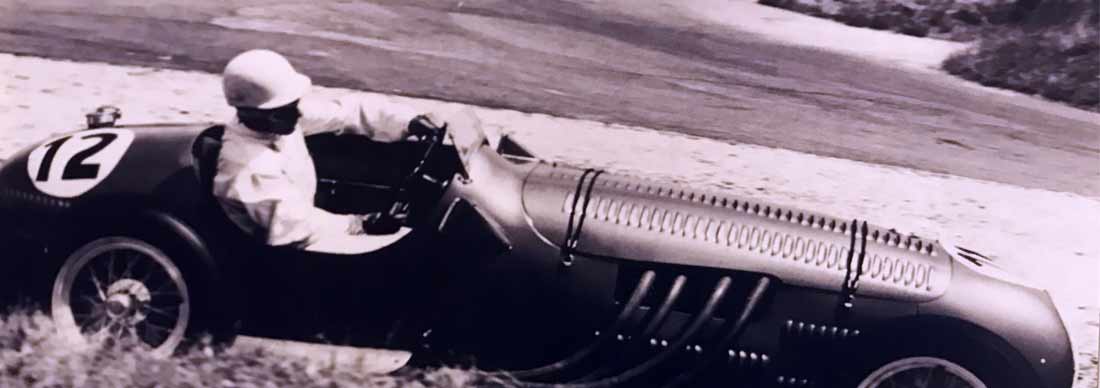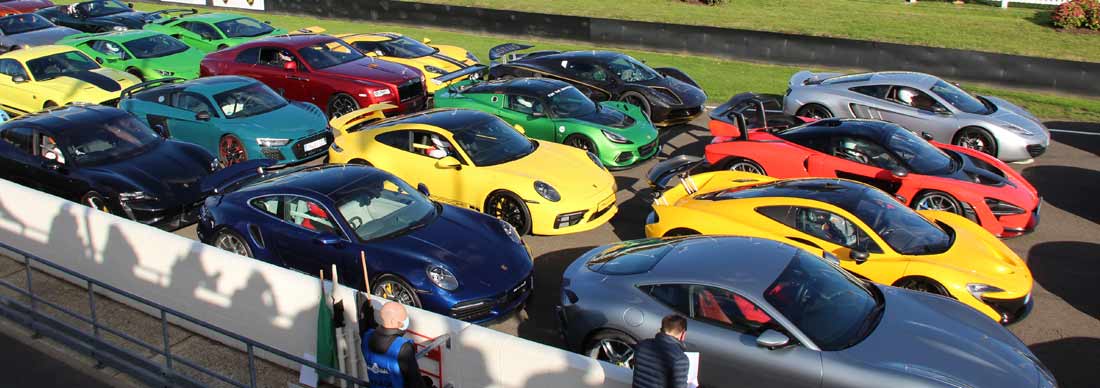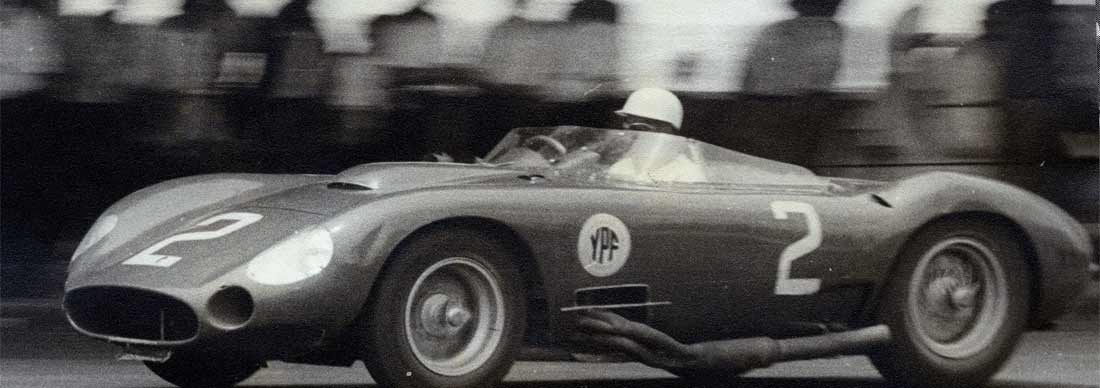
Stirling Moss - Important Steps - 1950, by Philip Porter
This extract is taken from Chapter 4 of ‘Stirling Moss - The Definitive Biography Vol 1’, by Philip Porter
The Bari GP was one of Stirling’s finest races to date. The grid contained the two 158 Alfas of Farina and Fangio, plus the works Ferrari team and supercharged Maseratis. The Alfas set a car-breaking pace and the Maseratis succumbed. The other two HWMs of Macklin and Fischer dropped out. Meanwhile, Moss was doing an incredible job to hold third place and after 200 miles (322km) finished just one minute 43.8 seconds behind Fangio. The fact that the Alfas had so much more power means that he must have been cornering far faster than the acknowledged masters.

Alf Francis, shattered after the journey from Reims, was mightily impressed. During the race, he was walking round the circuit to try and find Macklin’s abandoned car. In spite of Stirling’s amazing pace, he still spotted Alf, who was on the move, on each lap and signalled to him that he was walking the wrong way. Francis reckoned that this was the day the youngster came of age and even moved him to write to Alfred that night, saying his son 'sure is a champion'.
The Autocar was also impressed and had this to say: 'Stirling Moss really seems to have rung the bell at the Bari G.P. last Sunday, when he finished third in an unblown 2-litre H.W.M. less than two minutes behind the Alfa Romeos of Farina and Fangio. At one time (probably during the Alfa’s refuelling stops) he was in second place, and after Bira’s retirement with the fastest of the 4CLT Maseratis, Stirling was the only driver to keep within striking distance of the victors. The other H.W.M.s dropped out, as did Villoresi’s Ferrari.
'Result: Race distance 198.8 miles [320km], 1, Alfa Romeo (G. Farina), 2h 34m 29.6s, 77.22 m.p.h; 2, Alfa Romeo (J. M. Fangio), 2h 35m 13s; 3, H.W.M. (S. Moss), 2h 36m 56.8s; 4, Talbot (Levegh), 2 laps behind; 5, Ferrari (Cortese); 6, Maserati (Biondetti); 7, Ferrari (Serafini). Fifteen starters, eight non-finishers.'
Next day Stirling told Alf how he had danced with Miss Italy at the prizegiving. 'I thought to myself, “This is the other Moss. Still very much a youngster at heart. Very different from the cold, calculating machine in the HWM cockpit yesterday afternoon.’''
Miss Italy certainly seemed to get around!
More recently Stirling had this to say about the Bari race, clearly one of his finest. 'Farina had such style. I really enjoyed watching him but he was a real killer. He was a very tough driver. He was a hard driver, but certainly very good.'
When pressed as to whether ‘hard’ is a polite way of saying 'dirty', Moss responds, 'Yes, I suppose it is. His opinion of what was dirty and my opinion on the subject would be quite a distance apart. One has to realise that there were a few people like that. He was probably as bad as they came though. He was blamed for a few fatal accidents and had quite a few shunts himself.
'Both Farina and Fangio lapped me at Bari even though I was in third place in the 'offset' HWM. The two Alfettas came along and Farina really unnecessarily chopped me as he overtook me into a bend. I just managed to hold it but, because of his rough manoeuvre, he had put himself off line and he overcooked it. Even though I was in a much slower car, I re-passed him on the way out of the corner. Of course, he quickly passed me again and as Fangio came past - I will always remember - he was roaring with laughter. It was just so unnecessary.'
Robert Raymond comments that John Heath's jubilation after the Bari race was tempered by him spotting that Moss and Macklin had charged £12 worth of Coca Colas to his hotel account, a significant sum in those days. He further comments that Heath was utterly suspicious of his young charges (not quite so young in Macklin's case) until they were in his sight. The phrase, 'couple of naughty schoolboys' comes to mind.
He states that they were prone to consider themselves finished if, within three hours of arriving in a new town, they had not both been out to dinner with the two prettiest girls in the neighbourhood.
With a fortnight to kill between Bari and the next race in Naples, Heath, Tony Hume, Moss and Macklin went to Capri to relax. Short of crumpet, as Miss Italian Air Force had failed to respond to their invitation to join them from the mainland, they were seriously bored.
'There's only one thing for it, Stirl,' Raymond quoted Macklin as saying, 'We must go up to Monte Carlo. My mother is there at the moment, and we can stay with her and meet all the girls we want.' As there was the mere matter of a 1,400-mile/2,250km (1,200 miles/1,930km, according to Alf Francis) round trip, they asked Heath if they could borrow his trusty Citroen for a few days, without elaborating on the reason for enquiring. Unwisely, he agreed.
Sharing the driving, they knocked off the 700 miles (1,126km) in a day. However, sad to say, the girls were not over-impressed by these two Englishmen and the whole trip was a waste of time. Add to that the irony that Miss IAF had telephoned 15 minutes after they had caught the ferry to the mainland to say her parents had agreed to her travelling to Capri, a trip she then abandoned having discovered they had departed, and the whole exercise was a most unfortunate shambles!
Apparently, when they arrived back in Capri, they discovered that, for some extraordinary reason the front tyres were down to the canvas in places. Sounded as though a couple of racing drivers had been let loose in the car. Surreptitiously, they swapped them for the rears, figuring the state of them would be less obvious under the rear wings. Poor Heath.
After their sojourn on Capri, the HWM drivers motored to the Posillipo road circuit for the Naples Grand Prix, which was run in two heats and a final. All three HWMs – driven by Moss, Macklin and Fischer – qualified for the final, with Stirling winning his heat and making fastest lap. Competition in the final would come from Cortese’s 2-litre Ferrari and Fagioli’s OSCA.

On the grid Alf Francis discovered that Stirling’s car had a water leak. Moss told Francis that he had to open up a sufficient lead to make a pit stop if necessary. However, Cortese led initially and Stirling was being baulked by another driver who was deliberately blocking him. Macklin caught up and the two HWMs attempted to pass either side. The rotter moved to block Moss on the outside which allowed Macklin to slip through on the inside. As he swerved to try and stop Lance, Stirling slid through as well! Job done.
Both then caught the Ferrari and, passing it, looked set for a fine HWM one-two. But Stirling was going faster and faster, with a pit stop in mind. He came up to lap Berardo (or Bernardo) Taraschi in a 750cc (500cc according to two sources) supercharged Giaur on a fast bend. As Stirling had the car set up in a drift on the outside of the Italian car, the Giaur's tail slid out catching Stirling’s rear wheel and puncturing his tyre. Moss hit a very solid tree at about 85mph (137km/h). He broke his knee against the dash, knocked out two teeth and broke two more on the mirror mounting. Semi-conscious, he recalled Seaman’s fatal accident in 1939 when he failed to leave his crashed car and was engulfed in flames. Stirling dragged himself a few yards before collapsing.
According to Raymond, when Stirling regained consciousness, he was aware of a small group of monks bending over him. One offered him a water flask and this was when he discovered he had broken the teeth, for the raw nerves and cold water did not mix well. Reaching up to his mouth, he felt blood running down his face.
Meanwhile, there was considerable alarm back in the HWM pits as the first report to reach Heath, Hume and Francis was that he had succumbed to his injuries. This was supplanted by another stating he was seriously injured and lay dying at the side of the track. Rex Woodgate started running towards the scene while Heath headed for Race Control.
Macklin had seen the accident and it briefly put him off his stride and, as he momentarily slowed (or possibly spun, as one contemporary report suggested, to avoid Stirling's car), Cortese sped past to take the lead and win the race, Macklin finishing second (not first as one biographer states).

Moss had somehow got to his legs and was trying to hobble back to the pits, accompanied by much clapping from the sympathetic crowd. After a short distance, he collapsed and was carried back to the pits from whence he was removed to hospital. Alfred Moss learnt of the crash through the Reuters news agency and immediately flew out. Arriving at Stirling's hotel room, not knowing quite what to expect, he found a party in full swing. Knowing Stirling, he would not want to waste the time or the opportunity with all those nurses around!
The Autocar commented, 'The Italians, who produce at least their share of the world’s best road-racing drivers, were mightily impressed by both Moss and Macklin, reckoning them among the best drivers in the rising generation.'
Other articles by Philip
Images in this article were taken from the Stirling Moss Scrapbook 1929-1954.







Leave a comment
This site is protected by hCaptcha and the hCaptcha Privacy Policy and Terms of Service apply.